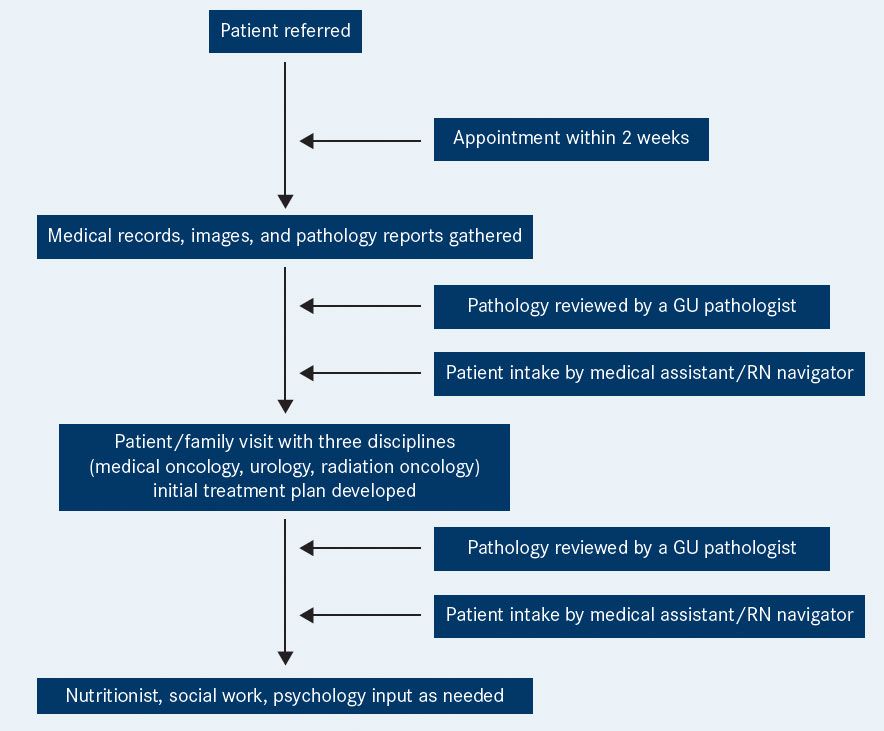One Clinic's Multidisciplinary Approach Optimizes the Use of Radium-223
With the advancement of radium-223 comes questions and controversy regarding optimal treatment sequencing, combination therapy, and appropriate patient selection.
Joseph F. Renzulli, II, MD
Patients who participated in a multidisciplinary care clinic experienced improved outcomes, especially when radium-223 was integrated into an overall treatment program. This is good news because while the advances in molecular oncology and targeted therapies have revolutionized treatment of many solid tumors and hematologic malignancies, improvements in treatment options for men with metastatic castration resistant prostate cancer (mCRPC) have been slower to develop.
However, since 2010 urologists and oncologists have embraced the development of Sipuleucel-T immunotherapy, cabazitaxel chemotherapy, the oral agents abiraterone and enzalutamide, and recently, Radium-223. All of the above agents confer an overall survival advantage in metastatic prostate cancer. However, with these advancements comes questions and controversy regarding optimal treatment sequencing, combination therapy, and appropriate patient selection.
Joseph F. Renzulli II, MD, and researchers, recently described an efficient and cost-effective workflow through a multidisciplinary care (MDC) clinic that relies on the collaboration between urologists, medical oncologists, radiation oncologists, nuclear medicine physicians and ancillary caregivers.
The model is particularly successful when radium-223 is incorporated into the patient’s treatment regimen. Their findings are published in the Journal of Multidisciplinary Healthcare.
The Genitourinary Multidisciplinary Clinic
Radium-223
“Our goal was to demonstrate that radium 223 is an ideal drug to incorporate into the treatment algorithm for mCRPC through a multidisciplinary collaborative effort. We believe more timely and effective utilization or radium 223 results from a multidisciplinary approach. It is the team approach that is important. There is no one specialty that is able to administer radium-223 given that it requires referral to a radiation oncologist or nuclear medicine physician, and that referral typically originates from a urologist or oncologist,” said Renzulli, an assistant professor at the Warren Albert Medical School at Brown University.The Genitourinary Multidisciplinary Clinic, opened in 2007, it incorporates 4 medical disciplines: medical oncology, radiation oncology, urologic oncology, and nuclear medicine physicians, with support from other services to enhance the patient experience and operational efficiency. Psychiatric services are provided for newly diagnosed patients, a licensed nutritionist is available for men receiving hormonal deprivation therapy, a nurse navigator assists in the treatment management process, and a nurse practitioner assists in patient management. The clinic also provides patients to access to a social worker as needed. Patients can be referred to the MDC through a urologist, a primary care physician following a new diagnosis of prostate cancer or for a second opinion. Prior to a new patient visit all outside pathology is reviewed by a dedicated genitourinary pathologist. The initial patient consultation includes reviews of radiologic films and pathology reports with the patient and family members, and an initial treatment plan is developed. The patient receives counseling about quality of life issues, treatment expectations, and patient goals to formulate the best individual treatment plan.Traditionally, radiation oncologists and nuclear medicine physicians rarely encounter a patient with mCRPC, unless referred by a urologist or a medical oncologist. The MDC setting allows these specialists to provide clinical input into the management plan, especially in light of the potential use of radium-223. Radium-223 is a new treatment that, unlike earlier radionuclide therapies, has shown an overall survival advantage in a large randomized phase 3 trial (ALSYMPCA). In the ALSYMPCA study, patients receiving radium-223 had a significantly prolonged time to onset of their first symptomatic skeletal event (median, 15.6 months vs 9.8 months; hazard ratio =0.66; 95% CI, 0.52—0.83; P <0.001) compared with those who received placebo. This treatment benefit and increased overall survival occurred independent of prior docetaxel therapy or concomitant bisphosphonate therapy.
Radium-223 is approved for treatment of patients with CRPC with symptomatic bone metastases and no known visceral metastases. The recommended dosing regimen is six cycles of 50 kBq/kg radium-223 therapy 4 weeks apart. As a calcium mimetic, radium-223 binds to hydroxyapatite at sites of osteogenesis associated with metastatic prostate cancer.
Figure. Flow of patients with mCRPC treated at The Miriam Hospital MDC

Abbreviations: mCRPC, metastatic castration-resistant prostate cancer; MDC, multidsciplinary clinic; GU, genitourinary; RN, registered Nurse
Radium-223 decays through emission of four high-energy alpha particles over an ultra-short distance, resulting in predominantly irreparable double-stranded DNA breaks in nearby cells that lead to cell death. The short range of alpha particles ensures that nearby cells (tumor) are affected to a greater extent than more distant (normal) tissues.
What’s the Sequence?
“What distinguishes radium-223 from sumarium- 153 and strontium-89 is that the others are utilized solely for palliation. It is important to distinguish an alpha emitter which offers an overall survival advantage from the other available treatments,” said Renzulli.There is significant heterogeneity in castration resistant prostate cancer. “We know by the AR-V7 mutation that there are some prostate cancers that may be resistant to the available oral therapies. We know that these individuals may respond better to upfront cytotoxic therapy with docetaxel,” said Renzulli.
“In terms of sequencing, the one thing that we have started to do is avoid using oral therapies sequentially. If a patient is on an oral therapy, such as Zytiga/prednisone and they start to demonstrate failure, we then use chemotherapy or radium 223. If they have an encouraging response we may then return to an oral therapy such as Xtandi, but we are definitely not using them back to back because of the cross resistance that we have seen.”
In the MDC, patients usually receive radium-223 therapy rather early in the course of their metastatic disease, when the disease burden is low with few bone metastases and no visceral metastases. Radium-223 therapy may be most effective at this point for prolonging survival and achieving the best outcome. Earlier use in patients with low tumor volume has the potential advantage of reducing disease burden, thus allowing more opportunity to sequence subsequent therapies during the patient’s treatment course.
Solo Practice and Efficiency of Care
Urologists do not receive training in administering chemotherapy, however with recent advancements, it is important that urologists be comfortable caring for prostate cancer patients concurrently receiving chemotherapy. “The CHAARTED and STAMPEDE trials have now brought chemotherapy to the frontline with respect to hormone sensitive metastatic prostate cancer” said Renzulli. “Urologists have to continue to coordinate care, in a multidisciplinary fashion, with radiation oncologist and medical oncologist to assure their patients are receiving cutting edge care. I think that’s of paramount importance in metastatic prostate cancer.”For solo practitioners, there is still a role for multidisciplinary care, said Renzulli. “The solo practitioner can team up with a medical oncologist, radiation oncologist and/or nuclear medicine physician and create a protocol for patients who are candidates for radium 223 and decide how they are going to manage the patient.” He said this doesn’t require the development of a “true” multidisciplinary center, but rather should incorporate “a collaborative effort where the physicians have an arrangement where patients will have access to multiple healthcare specialist caring for the patient with mCRCP.”
Though many clinicians believe that providing care in an MDC is inefficient and costly to their overall practice, overall survival rates for patients with advanced prostate cancer have been superior when treatment is delivered through a MDC. The researchers wrote that the “multidisciplinary approach fosters improved surgical outcomes with decreased surgical complications, resulting from increased surgeon experience and surgical volume, enhanced radiation oncology options, increased participation in clinical trials and high patient satisfaction.”
It may also enhance the confidence of referring physicians that patients are receiving optimal therapy and may reinforce the decision to refer patients, rather than to continue managing them alone. The approach reduces the likelihood that patients will be viewed as typical and treated with a standard regimen when their disease characteristics indicate an alternate approach, or in a changing treatment environment where former standards are no longer recognized as optimal.
“Radium-223 provides an overall survival advantage and reduces symptomatic skeletal related events. It mandates coordination of care between at least two disciplines, a urologist or medical oncologist with a radiation oncologist or nuclear medicine physician. This collaborative effort is critical to ensure the patient has the opportunity to complete the 6 cycles of therapy,” concluded Renzulli.
1. Renzulli JF 2nd, Collins J, Mega A. Radium-223 dichloride: illustrating the benefits of a multidisciplinary approach for patients with metastatic castration-resistant prostate cancer. J Multidiscip Healthc. 2015;8:279-286.




